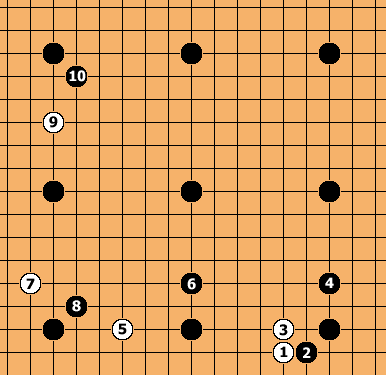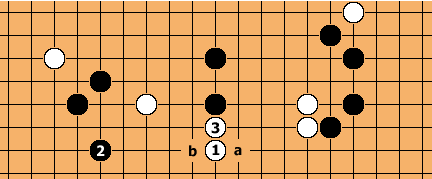Reprinted from "The American Go Journal," Vol. 27, No. 2: 1993. Written by Bob Terry (5 dan).
This selection of excerpts is reprinted under fair use. Original transcription taken from Sensei's Library.
Commandment 1: You must always make your opponent's stones heavy.
Black 2 and 4 are perfect examples of this rule. With 2, Black threatens to [hane] at 3, which would create a powerful position ensuring profit in the corner and even better potential profit on the right side of the board, where Black has a handicap stone ideally situated on the middle star point.
So White is forced to extend to 3. This may be described as the "lesser of two evils," but that is all that this move has going for it. White's two stones, 1 and 3, are heavy, as heavy as dragging around a club foot. This will always be a matter of concern for White, from now until the end of the game. These heavy stones will continue to be heavy, there's no avoiding it. All that one can do is try to exact retribution when the opponent makes an attack in earnest.
Commandment 2: You must always keep the opponent's stones separated.
I attacked Black's other corner with 5, leaving my heavy two stones on the right to their fate. I wanted to see how Black would respond to the new challenge. Once again Black answered with a textbook perfect response at 6. This one point jump denies an easy connection among White's forces and ensures that White has a hard row to hoe to achieve a playable game.
Black's one point jump to 6, while excellently played, left White free to initiate a double attack against the corner with 7.
At this point I was hoping that Black would try to engage me in a jousting match in the corner where my superior training and reading skills would quickly tell to my advantage. Alas! It was not to be! Black 8 again conforms to the Second Commandment by separating White's forces.
Please keep this move in mind whenever you play go.
Commandment 3: One must always respond to the opponent's move.
This is such an elementary concept that it's almost laughable to actually atate it in writing, but it is one that is constantly violated by beginners. The reason is simple: the beginner does not realize the significance of the stronger player's motive and just guesses about where to play his own move.
Commandment 3.5 (a corollary to Commandment 3): Don't make pointless moves.
Black 6 here is a completely pointless move. It does not attack White and it does not stabilize Black's position. It does not make territory on the upper side because it is too high, being on the fifth line. Deduct 10 points from Black's score.
Where should Black play instead? How about A?
Commandment 4: One must not respond automatically to the opponent's moves.
This is the flip side to the Third Commandment. One must respond to the opponent's moves, but not blindly, playing by rote. This allows your opponent to take control of the rhythm of the game and dictate the flow of play.
When White played at 1 here, Black answered at 2, again violating the Third Commandment. Black 2 is no answer at all to White's move. To respond effectively, Black must play at White 3 himself. If White plays at A, Black answers at B. If White played at B, Black would answer at A. In other words, White must choose between reinforcing either his two stones on the right or his other stone on the left.
But Black 2 here also violates..
Commandment 5: One must not allow the opponent to make thick moves when it can be avoided.
This is one of the hardest things for a beginner to understand.
A thick move is usually also a slow move, that is, it does not develop one's position quickly. Also, many times, a thick move is not directly concerned with making territory. Thus a beginner finds trouble categorizing such moves or recognizing opportunities for playing them.
As one becomes more experienced, one learns to equate thick moves with strength, an essential component of the game. If one can face an opponent from a position of strength, both attack and defense are made easier. In this case, White 3 is the vital point. (Also, remember the go proverb: My opponent's key point is my own.)
Commandment 6: Do not try to fight with the opponent.
This may seem to be a strange pronouncement. After all, fighting is what the game is all about, isn't it?
Well, no, the object of the game is to win. As you may notice, White generally doesn't fight much in the early stages of these high handicap games. White only tries to build solid positions, create thickness, or invade Black positions.
It would not make sense for White to challenge Black to a fight when all of those handicap stones give Black such an advantage. For Black's part, he is playing against a much stronger opponent. Why start a fight? Would you challenge a prize fighter to a slugfest? What could you possibly hope to accomplish?
Commandment 7: One must strive to discover the true nature of the position.
This is by far the hardest one to adhere to, both for beginners and strong players alike. One must calm one's emotions and patiently examine any number of questions that relate to the position.
(Scartol notes: In the game, Terry makes it look like he is trapped with only one eye. In reality, White is patiently surrounding Black's corner, turning the tables, and capturing a huge group. This speaks to the fact that in a 9 stone handicap game, White is probably able to read much further into a position than Black is, and therefore quite likely to use this sort of bait-and-switch maneuver. Black, therefore, must try at all times to recognize the true nature of the position, rather than its surface deception. This is directly related to the next commandment.)
Commandment 8: One must learn how to read out variations.
This may be restated: If, in violation of the Sixth Commandment, you do pick a fight with your opponent, make sure that you win! (Scartol: This is a reference to the same fight. Black thought he could surround White and kill her, but he had miscounted. White used the mistake to slam Black and make a huge profit from which Black could never recover.)
Commandment 9: One must learn to count.
There are many situations where one must be able to count in order to determine the true nature of the position. This race to capture is one example.
One must also learn to count the territory on the board. When it's clear that Black cannot possibly regain the points lost from mistakes along the way, it's time to put Commandment 10 into effect.
Commandment 10: One must know when to resign.
Even when Black was behind by 30 points, he continued to play on before losing by a much larger margin. Even at that point, he asked to replay the game from an earlier position to "see how it would have ended"! This is discourteous to one's opponent. One must learn to resign properly and at the proper time.
In other games, such as chess for example, draws and stalemates are possible. Not often in Go. It is impossible not to lose at least some of one's games; if one manages to win 75% of the time, it is a fine accomplishment. (Scartol: 75%! Ha! Would that I could win half of my games!) So losing is part and parcel of playing Go. It is no disgrace to do so.
Not accepting this reality, though, may perhaps be considered disgraceful. In any event, one should by all means accept a loss with good grace. I find that the words: "I resign. You played very well. Thank you for the game" work nicely.
![[Everything Shii Knows]](../mediawiki/skins/common/images/wiki.png)


